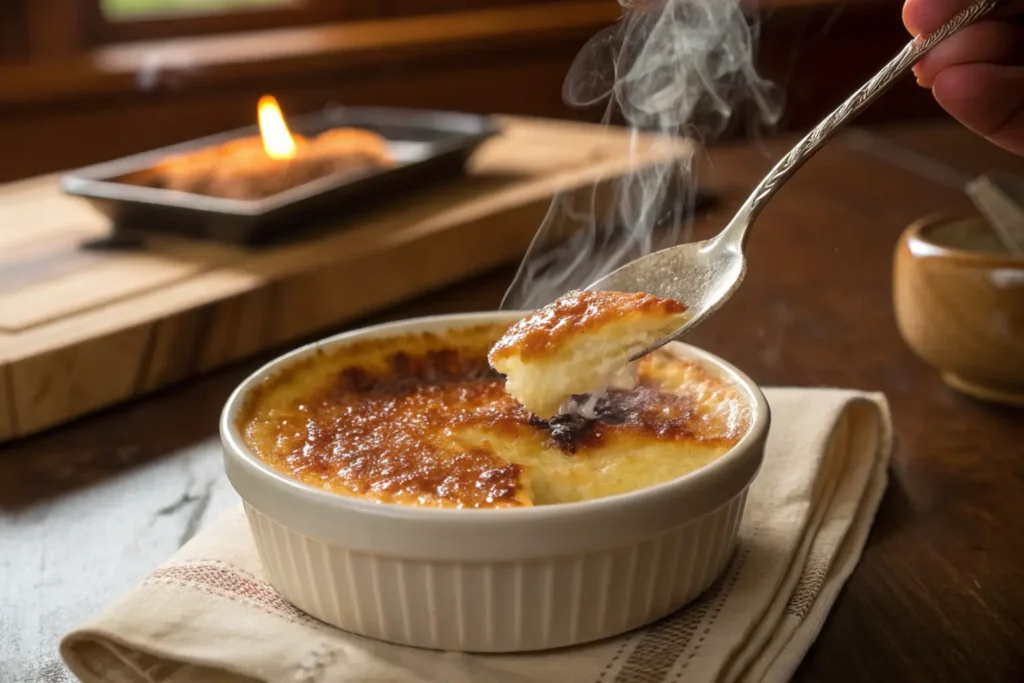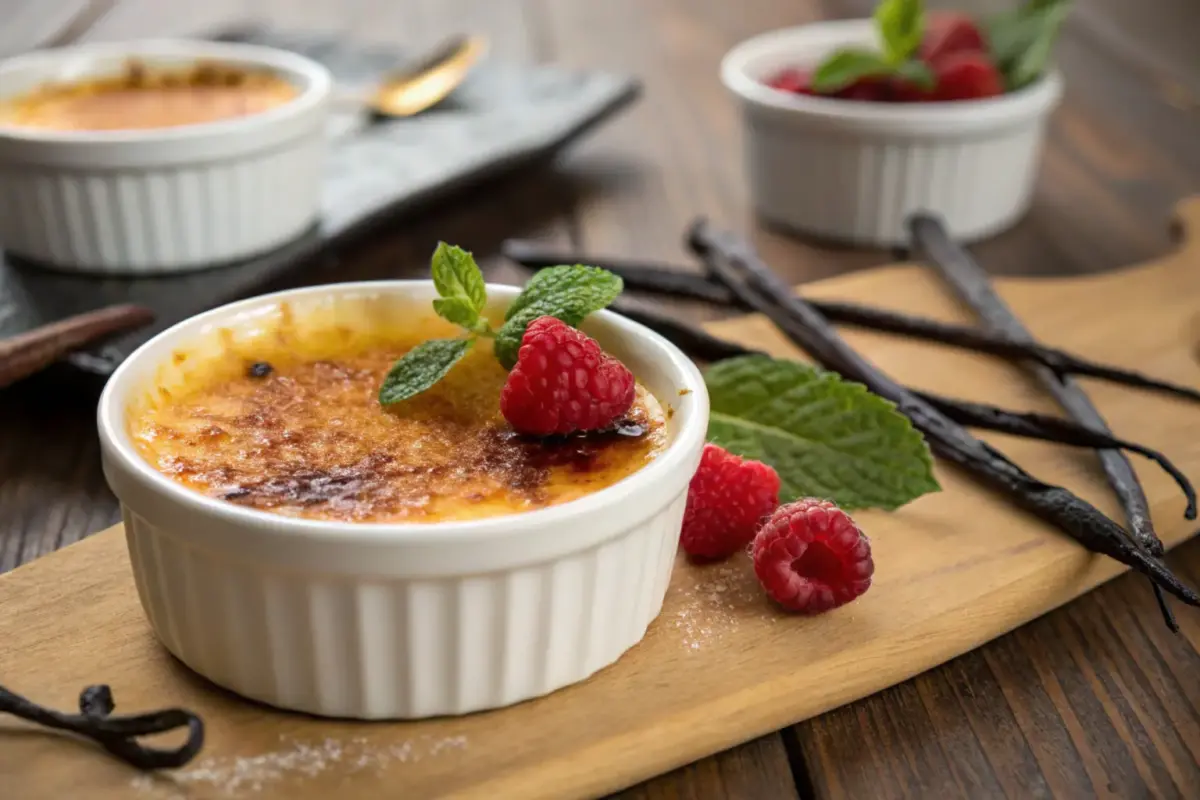Introduction to Crème Brûlée Taste
Crème brûlée is a classic dessert that has captivated taste buds for centuries. Originating in France, this luxurious treat dates back to the late 17th century. Its name, meaning “burnt cream,” reflects the signature caramelized sugar layer that crowns its velvety custard base. While traditionally associated with French cuisine, crème brûlée has evolved into a global favorite, appearing on dessert menus worldwide.
The dessert holds cultural significance beyond its delightful taste. It symbolizes indulgence, elegance, and meticulous craftsmanship. Over time, it has become a staple in fine dining establishments, often regarded as a litmus test for a chef’s skill. Its versatility allows for subtle adaptations that cater to diverse palates, contributing to its enduring popularity.
This delightful dessert continues to intrigue dessert enthusiasts, prompting many to wonder, what does crème brûlée taste like? The answer lies in its carefully chosen ingredients and masterful preparation techniques.
Ingredients That Define Its Flavor
Cream and Egg Yolks
At the heart of crème brûlée lies its simple yet rich base of cream and egg yolks. First and foremost, the cream imparts a lush, velvety texture that coats the palate, while the egg yolks lend structure and a subtle depth of flavor. This combination creates a custard that is both delicate and indulgent, providing a perfect canvas for the dessert’s other elements.
Furthermore, the quality of these ingredients plays a crucial role in defining the taste. For instance, fresh cream delivers a pure, milky sweetness, whereas high-quality egg yolks contribute a faintly savory undertone. As a result, they form a harmonious balance that is both comforting and luxurious. In addition, the interplay between these two ingredients sets the foundation for the dessert’s signature flavor.
Sugar and Vanilla
Sugar is an indispensable element in crème brûlée, serving both as a sweetener and as the basis for its signature caramelized topping. Specifically, when sugar is torched to create the characteristic “burnt” layer, it transforms into a bittersweet shell that complements the custard’s creamy richness.
Similarly, vanilla enhances the dessert’s flavor profile. Often added in the form of extract or whole beans, the subtle, aromatic notes of vanilla provide warmth and complexity, which tie together the cream and sugar in a seamless blend. Moreover, its presence elevates the dessert’s overall appeal by adding depth and sophistication to the flavor. Consequently, the combination of sugar and vanilla is essential to the dessert’s success.
Optional Flavorings
While traditional crème brûlée relies on its classic ingredients, modern variations often incorporate optional flavorings to add a creative twist. For example, citrus zest, such as orange or lemon, brings a refreshing brightness, while liqueurs like Grand Marnier or Amaretto introduce a sophisticated edge. Additionally, spices such as cinnamon or cardamom can provide an exotic flair. These additions, in particular, can amplify the dessert’s appeal without overshadowing its inherent charm. Furthermore, they showcase how versatile crème brûlée can be, allowing it to cater to diverse palates and preferences.
Texture and Mouthfeel
The Contrast Between the Creamy Custard and Caramelized Sugar
One of the most remarkable aspects of crème brûlée is the contrast between its silky custard base and the brittle caramelized sugar topping. To begin with, the custard’s smooth, creamy texture melts effortlessly on the tongue, providing a sense of indulgence that is hard to match. On the other hand, the sugar crust adds a satisfying crunch, creating a delightful interplay of textures in every bite.
Furthermore, the juxtaposition of these textures enhances the overall eating experience. The brittle topping provides an initial resistance that shatters to reveal the custard’s softness, making each spoonful uniquely enjoyable. As a result, this combination of textures not only heightens the dessert’s appeal but also contributes significantly to its taste perception.
Why Texture is Key to Taste
Texture is often as important as flavor when it comes to desserts, and crème brûlée is no exception. For instance, the creamy mouthfeel of the custard allows its rich flavors to linger, while the crisp sugar topping introduces a contrasting sensation that keeps the palate intrigued. Additionally, the interplay between these textures ensures that the dessert remains engaging from the first bite to the last.
In addition, the balance of textures reflects the skill and precision required to prepare crème brûlée. A custard that is too firm can feel heavy, while a sugar crust that is too thin lacks the satisfying crunch. Consequently, achieving the ideal texture is not only a matter of technique but also a key element in delivering the perfect crème brûlée experience.
Sweetness Levels
Balancing Sweetness in Crème Brûlée
A well-made crème brûlée achieves a delicate balance between sweetness and richness. The custard is subtly sweet, allowing the natural flavors of the cream and vanilla to shine. This restrained sweetness ensures that the dessert never feels cloying, even after multiple bites.
The addition of the caramelized sugar topping introduces a new layer of sweetness. However, the slight bitterness from the burnt sugar prevents the dessert from becoming overly saccharine. This balance is a testament to the careful artistry behind its preparation.
The Role of Burnt Sugar in Moderating Sweetness
The burnt sugar crust is not merely decorative; it serves a crucial function in moderating the overall sweetness of the dish. By introducing a hint of bitterness, it offsets the custard’s richness, creating a flavor profile that is complex and nuanced. The juxtaposition of sweet and bitter ensures that each bite remains intriguing and satisfying.
The Flavor Profile of Crème Brûlée

Creamy and Rich Base Notes
At its core, crème brûlée is defined by its creamy, rich base. The custard exudes a luxurious flavor reminiscent of fresh cream, with a subtle hint of eggs adding depth. These base notes provide the foundation for the dessert’s more intricate flavors to shine.
Hints of Vanilla
Vanilla is often described as the soul of crème brûlée. Its warm, aromatic qualities infuse the custard with a comforting sweetness that lingers delicately on the palate. The presence of real vanilla beans, with their tiny specks visible in the custard, elevates the dessert’s flavor to new heights.
Subtle Caramelization Adds Complexity
The caramelized sugar topping is where crème brûlée’s complexity truly emerges. As the sugar is torched, it undergoes a transformation that adds depth and intensity to its sweetness. The resulting caramel notes range from toasty to slightly bitter, introducing an intriguing contrast to the custard’s softness.
Variations Across the Globe
Crème brûlée’s popularity has led to countless regional variations that incorporate unique ingredients and flavors. In Japan, matcha crème brûlée offers a subtle earthiness from powdered green tea. Italian adaptations may include espresso for a robust coffee flavor, while tropical regions experiment with coconut milk for a lighter twist.
These creative adaptations maintain the dessert’s essence while celebrating local tastes. The versatility of crème brûlée ensures that it remains a beloved treat, no matter the cultural context.
Crème Brûlée vs. Similar Desserts
When compared to other custard-based desserts, crème brûlée stands out for its distinctive texture and flavor profile. Unlike flan, which features a caramel sauce, crème brûlée’s caramelized sugar layer is solid and crunchy. Panna cotta, while similarly creamy, lacks the depth provided by the burnt sugar topping. Traditional custards, often served without any topping, feel simpler in comparison.
What makes crème brûlée truly unique is its ability to combine contrasting textures and flavors into a cohesive and satisfying dessert. Its caramelized sugar crust and rich custard base are unmatched in their elegance and appeal.
How It’s Made: The Culinary Process
Preparing the Custard
Creating crème brûlée starts with a delicate balance of cream, egg yolks, sugar, and vanilla. The ingredients are whisked together until smooth, then gently heated to combine flavors without curdling. The mixture is poured into ramekins and baked in a water bath, ensuring an even, creamy texture.
The water bath is crucial as it prevents overheating, which can result in a grainy custard. Slow cooking allows the ingredients to meld seamlessly, creating the rich, silky base that defines crème brûlée’s texture.
Achieving the Perfect Caramelized Crust
The caramelized sugar topping is the hallmark of crème brûlée. Once the custard cools, a thin layer of sugar is evenly spread over its surface. Using a kitchen torch, the sugar is melted and browned, forming a brittle, golden crust.
This process requires precision; over-caramelizing can lead to bitterness, while under-caramelizing results in a soft, unsatisfying topping. The ideal crust shatters under the spoon, adding a delightful crunch to every bite.
Best Occasions to Enjoy Crème Brûlée
Crème Brûlée in Fine Dining
Crème brûlée is a staple in fine dining establishments, often served as a show-stopping dessert. Its sophisticated presentation and luxurious flavor make it a fitting conclusion to an elegant meal. The torching process, often done tableside, adds a touch of drama that enhances the dining experience.
Celebrations and Special Events
This decadent dessert is also popular at celebrations, from weddings to anniversaries. Its indulgent taste and elegant appearance make it a favorite for special occasions. Some hosts even personalize crème brûlée with flavored variations or decorative toppings, ensuring it stands out as a memorable treat.
Common Pairings for Crème Brûlée
Wines and Beverages
Crème brûlée pairs beautifully with a variety of wines and beverages. Sweet wines like Sauternes or Moscato complement its rich flavors, while dry Champagne adds a refreshing contrast. For non-alcoholic options, a robust espresso or fragrant tea, such as Earl Grey, works wonderfully.
Fruits, Nuts, and Other Accompaniments
Fresh fruits, such as raspberries or figs, provide a tart contrast to crème brûlée’s sweetness. Toasted nuts like almonds or pistachios add crunch and depth, enhancing the dessert’s complexity. These accompaniments highlight the versatility of this classic treat.
Nutritional Insights
Calorie Count and Ingredients
Crème brûlée is undeniably indulgent, with its rich custard and sugary topping. A typical serving contains around 250–300 calories, depending on portion size and recipe variations. While high in fat due to the cream and egg yolks, it remains a treat meant to be savored in moderation.
Gluten-Free Options
For those with dietary restrictions, crème brûlée is naturally gluten-free, making it an excellent dessert choice. However, it’s essential to verify that no additional ingredients, such as flavored syrups, contain gluten.
How to Identify a Good Crème Brûlée
Signs of Quality in Flavor, Texture, and Presentation
A high-quality crème brûlée boasts a silky, smooth custard with no signs of curdling. The flavor should be rich yet balanced, with pronounced vanilla notes and a hint of caramelization. Its sugar crust should be evenly caramelized, providing a satisfying crunch without bitterness.
Presentation also matters. A properly made crème brûlée has an inviting golden-brown crust and may include garnishes like a single berry or mint leaf for visual appeal.
Tips for Making Crème Brûlée at Home
Equipment and Tools Needed
To make crème brûlée at home, you’ll need basic tools like ramekins, a whisk, and a baking dish for the water bath. A culinary torch is essential for achieving the signature caramelized crust. Using high-quality ingredients, such as fresh cream and real vanilla beans, is key to success.
Common Mistakes and How to Avoid Them
- Overcooking the custard: This results in a grainy texture. Always bake in a water bath at a low temperature.
- Uneven caramelization: Ensure an even sugar layer and use a steady hand when torching.
- Rushing the process: Allow the custard to cool completely before adding the sugar topping for the best results.
Fun Facts About Crème Brûlée taste
Historical Trivia
Crème brûlée’s origins are often attributed to France, but variations have appeared in England and Spain under names like “Trinity Cream” and “Crema Catalana.” Its enduring popularity stems from its universal appeal and adaptability.
Celebrity Chefs’ Takes on Crème Brûlée
Renowned chefs like Julia Child and Gordon Ramsay have praised crème brûlée for its simplicity and elegance. Many chefs add their unique twists, such as infusing the custard with lavender or experimenting with exotic toppings like candied bacon.
Why Crème Brûlée taste is a Timeless Dessert
Its Enduring Appeal Over Centuries
Crème brûlée’s charm lies in its perfect balance of simplicity and sophistication. Its straightforward ingredients and preparation belie the depth of flavor and texture it offers. This timeless quality has allowed it to remain a favorite for generations.
Adaptability in Modern Cuisine
Modern chefs continue to innovate with crème brûlée, incorporating contemporary flavors and techniques. From vegan versions made with coconut milk to unconventional presentations, the dessert’s versatility ensures its relevance in today’s culinary landscape.
FAQs About Crème Brûlée
1. What does crème brûlée taste like?
Crème brûlée has a creamy, rich flavor with notes of vanilla and a hint of caramel from its burnt sugar topping.
2. Is crème brûlée difficult to make at home?
With the right tools and patience, crème brûlée can be made successfully at home. Precision in timing and temperature is key.
3. How is crème brûlée different from flan?
While both are custard-based desserts, flan features a caramel sauce, whereas crème brûlée has a hard, caramelized sugar crust.
4. Can crème brûlée be made without a torch?
Yes, a broiler can be used to caramelize the sugar, but a torch provides more control and precision.
5. What are some popular flavor variations?
Popular variations include matcha, chocolate, espresso, and citrus-infused crème brûlée.
6. How do you store leftover crème brûlée?
Cover it tightly and refrigerate for up to two days. Avoid adding the sugar topping until just before serving.
Conclusion
Crème brûlée is a dessert that embodies elegance and indulgence. Its creamy custard, contrasting with a caramelized sugar crust, creates a harmonious blend of flavors and textures that delights the senses. Whether enjoyed at a fine dining restaurant or crafted at home, crème brûlée offers a timeless taste experience.
If you haven’t yet had the pleasure of savoring crème brûlée, now is the perfect time to try this exquisite treat. Its rich history, unique flavor profile, and endless variations ensure that it will remain a favorite for generations to come.


1 thought on “What does crème brûlée taste like?”